When I started the current iteration of this project, I already had a mostly-functional project, with the exception of how I kept track of the keg volumes. I was using strain-gauges of the same type used in bathroom scales for quite a while, with okay results outside of 2 main issues: The first is simply that when I originally built the Keezer, I didn’t plan for scales and thus had to make some modifications in order to accommodate the extra height added by the scales; my fix was a bit hacky but worked well enough. The bigger issue comes down to the simple fact of what a Keezer is; a freezer with a temperature controller to keep it a bit ABOVE freezing. Normally in a freezer, condensate is simply turned into ice that periodically has to be removed by hand, but in my case it just pools in the bottom of the freezer and has to be mopped out every few weeks (more in the summer, less in the winter). It can get a little gross, but the kegs don’t particularly mind (and most importantly, it doesn’t come into contact with the beer). Funny thing is, strain-gauges don’t really like sitting in water (at least when they’re not corrosion resistant). This meant that as time went on, the strain-gauges slowly succumbed to the elements and became less accurate (or more precisely, their values tended to drift over time).
I did a bit of research on how to address these shortcomings over the years, and ultimately, I decided to go with some inexpensive flowrate meters. Not laboratory accurate, but presumably good enough for my needs. After buying one and testing it out over a few weeks at different carbonation pressures (I was a little concerned the carbonation might skew the readings, which it mostly didn’t), I went ahead and bought enough for all of my kegs and began building out the new code. Since I had originally used a Particle Photon as the microcontroller, all the code was written in a variation of C++. Pretty simple, but nothing compared to the simplicity of ESPHome. The first thing I did was write all of the YAML (simple, but surprisingly it still added up). Over a few days, I slowly built up my ‘virtual’ Keezer until it seemed to function the way I wanted.
In addition to switching to flowmeters, I decided to add a pressure sensor (located after the regulator on my CO2 tank, but before the regulators I have for each keg). Normally this part of the lines stays at a steady 40psi (the max pressure I ever want to provide to any keg), and while I left a scale on the tank, this allows me to both tell when the tank is COMPLETELY empty as well as troubleshoot other issues without opening the Keezer (Did I shut the CO2 tank off when I swapped it out and forget to turn it back on? Or is there something else wrong?). Far from a necessity, but I previously had a pressure sensor which I found useful until it failed. I also decided to add a relay and directly regulate the temperature/control the freezer instead of using a standalone temperature controller. ESPHome just makes this so easy; when using C++ I had considered this but was always afraid I would miss an edge case and damage the compressor. With ESPHome and a few lines of YAML, I can define exactly how I want it to operate and feel confident that at least on the software side of things, it will operate the way I intend. The remaining upgrades I made included adding individually addressable LEDs (instead of just white) under the taps, as well as replacing the screen (an old laptop screen connected to a Raspberry Pi) with a tablet that shows a dashboard from Home Assistant (instead of an HTML file I was using previously).
While I previously had a temperature sensor just for data, it was a simple analog one designed to be placed on a circuit board that I just soldered to some wire. I decided to replace and upgrade it as well, using a digital sensor (dallas) actually designed for placement in a wet environment. Nothing fancy, but it’s little improvements like this that make the finished product feel, well, finished.
In my previous build I had solenoid valves on each tap; I left them in place and simply cleaned up the wiring before integrating them into my new board. I also left the weight sensor I had made for the CO2 tank, as it’s not in a wet environment and I never had any issues with it. All that was required was to salvage one of the HX711 amplifier boards from the old PCB for use in my new one. Additionally, I previously had some LEDs installed on the interior for when the Keezer is open which were simply wired to a doorswitch (same as is used for closet doors to make the lights come on automatically). While this worked just fine, I decided to connect the door sensor and the LEDs to my new PCB. Entirely unnecessary, but hey, this whole project is exactly that and you never know when one might want to automate something based on opening the inside of the Keezer.
The physical upgrade process was straightforward, but as these types of projects always go, took me a bit longer than I anticipated. Over the course of a few weeks, I slowly pulled all the old electronics out and began to add the new. Somewhat surprisingly, I didn’t run into anything particularly unexpected. The final piece was milling my own custom PCB for everything. It ended up being a little bit of a challenge fitting everything onto the size boards I had on-hand, but a little PCB Tetris solved those issues.
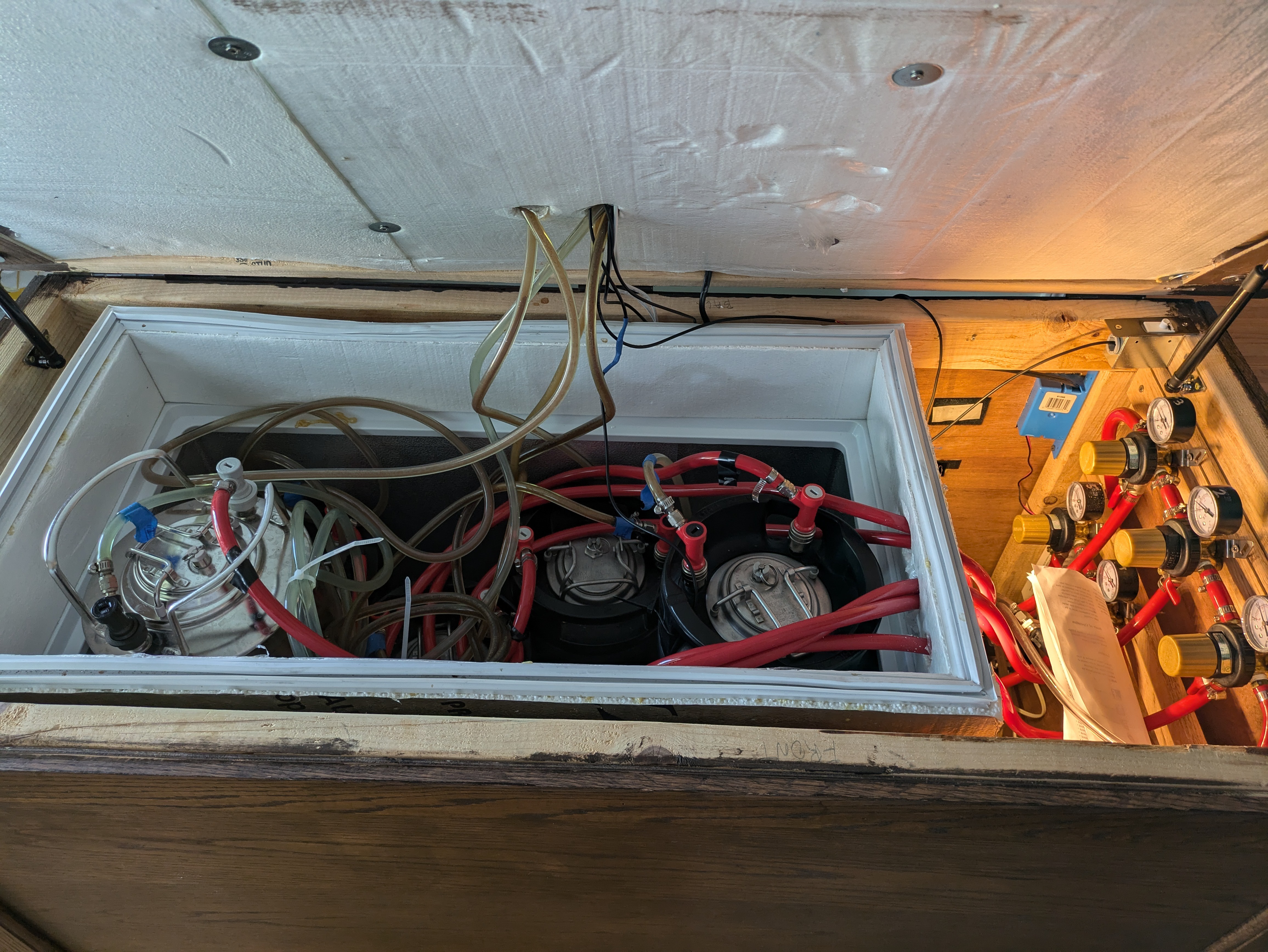
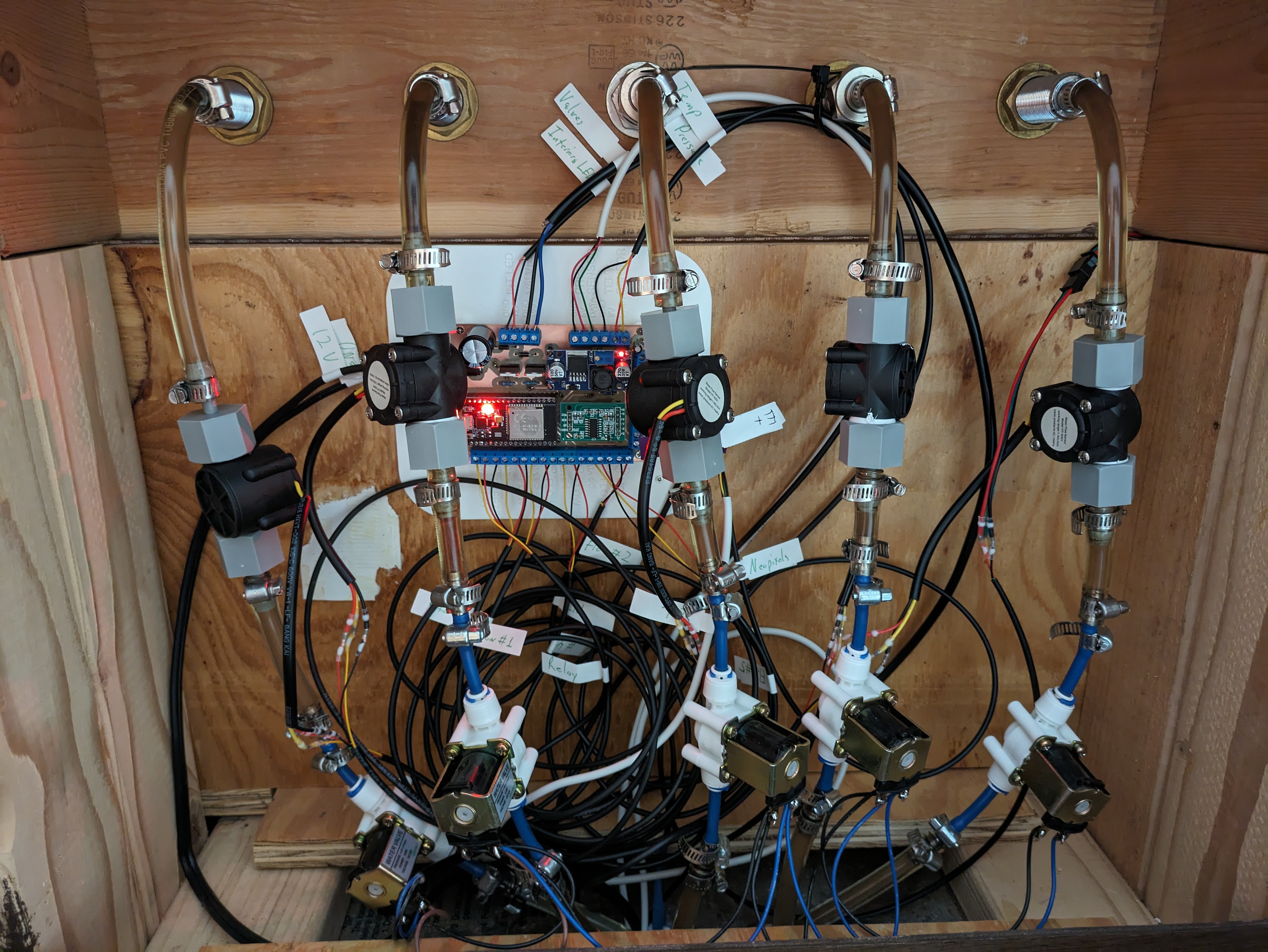
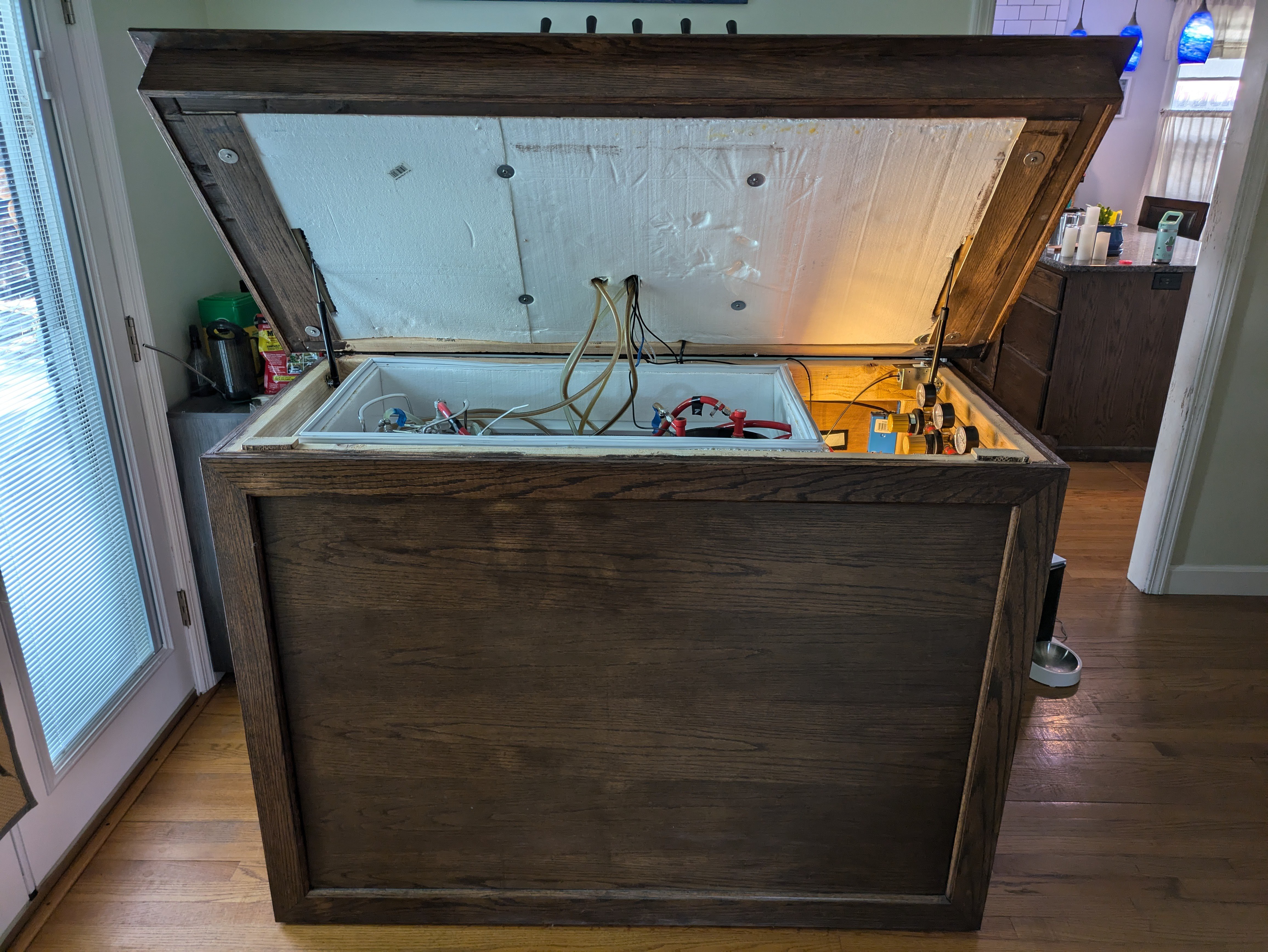
After connecting everything up and testing this out, it was simply a matter of making up a Home Assistant dashboard that I was happy with. This is still a work in-progress, but I’m reasonably happy with what I have so far. Because I have a tablet display now, I have it running all the time displaying a weather dashboard and automatically switch it to the Keezer dashboard when it’s turned on. One thing that I always ran into previously was guests struggling to identify which beer is in each tap. While I thought a simple left to right numbering system made sense, people would still get confused. Since I used to print my own caps when I bottled, I have continued designing a simple cap/logo for each beer and always pick a color for it as well to make identifying them easier. With this already in place, I decided to take advantage of my new individually addressable LEDs and color the lights under each tap to match the beer. Time will tell whether I keep this; it’s fun but can also look a little hectic (and be confusing when the color is for instance gray or black, not to mention when a tap is currently empty).
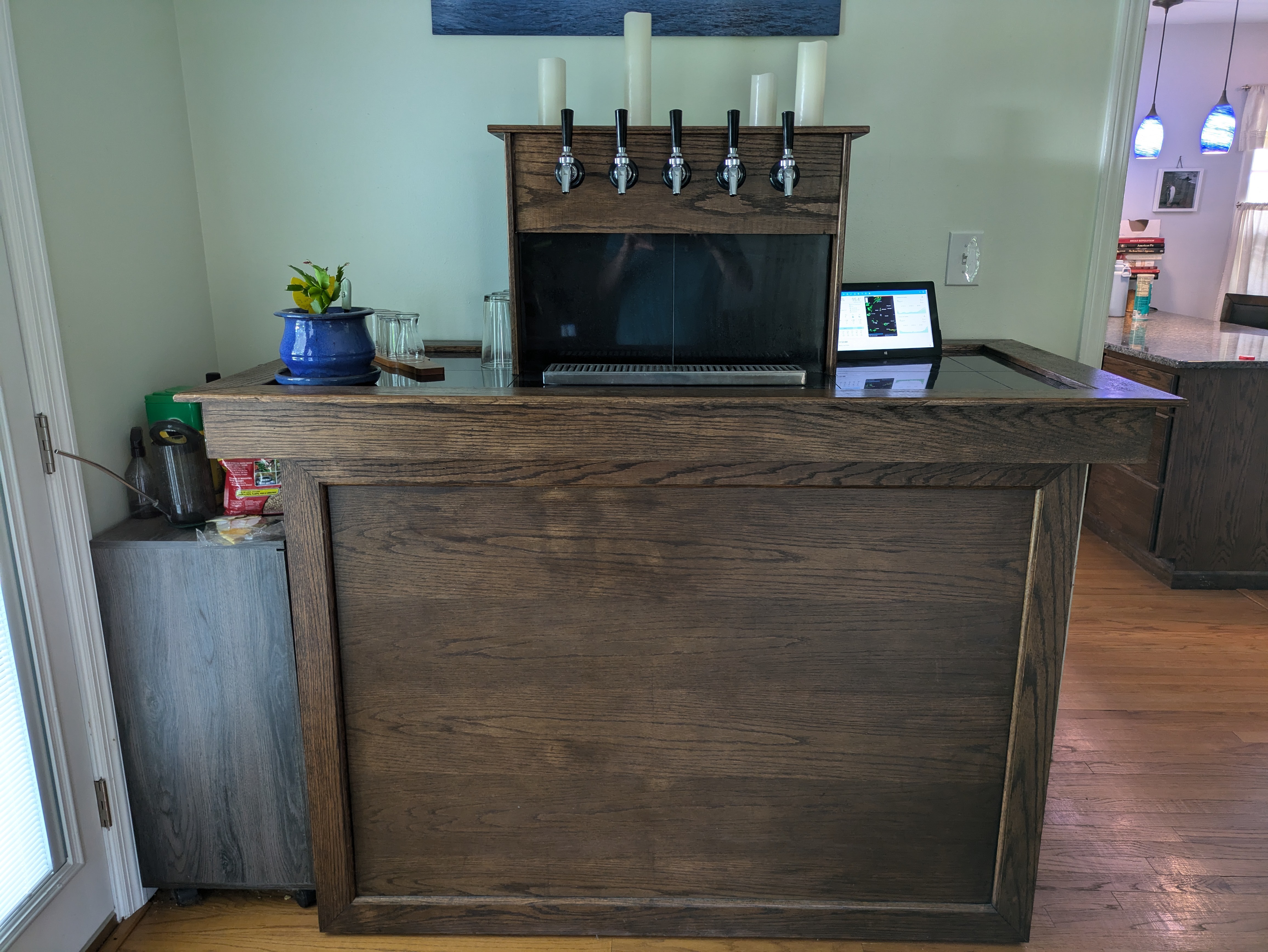
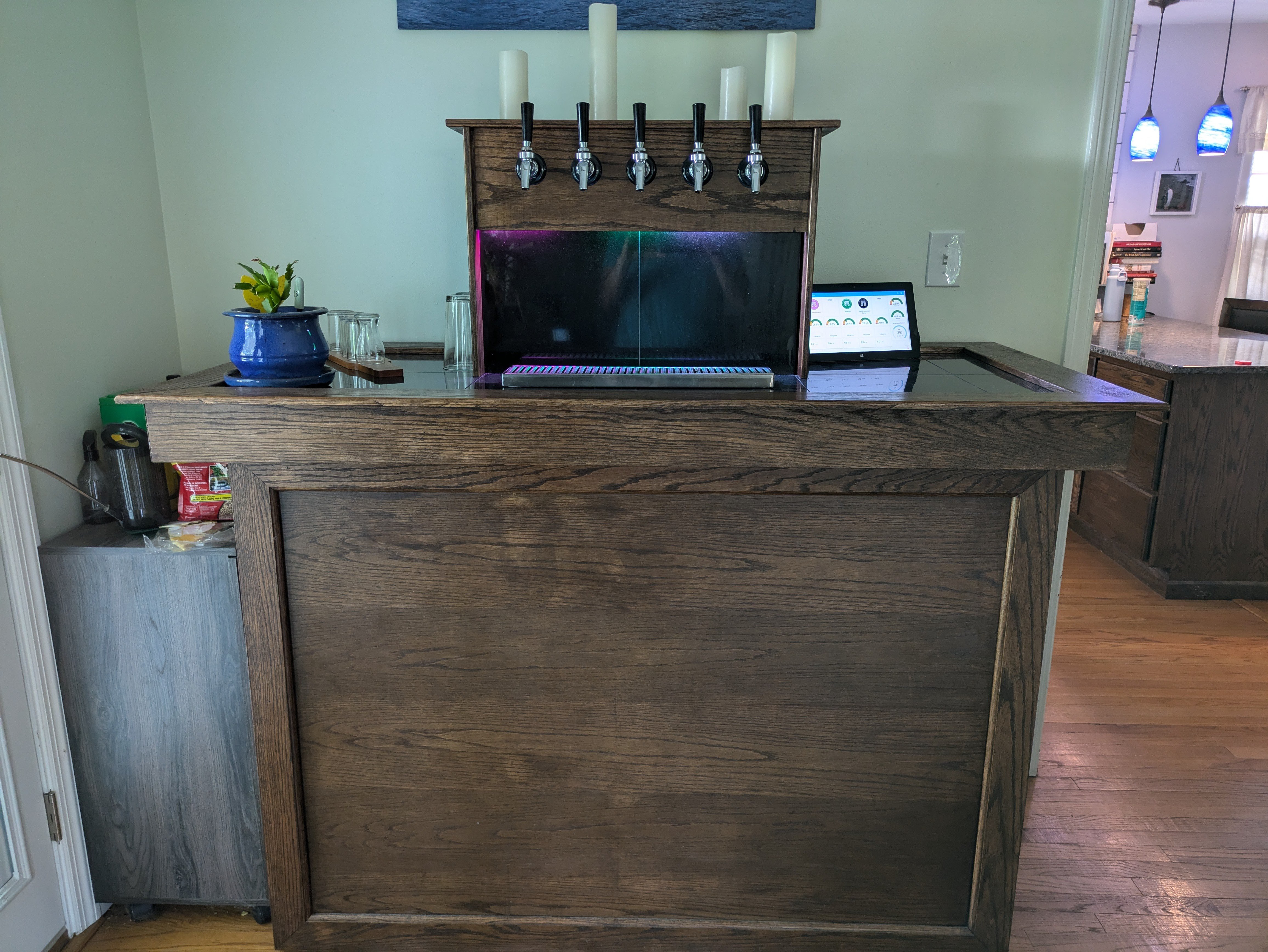
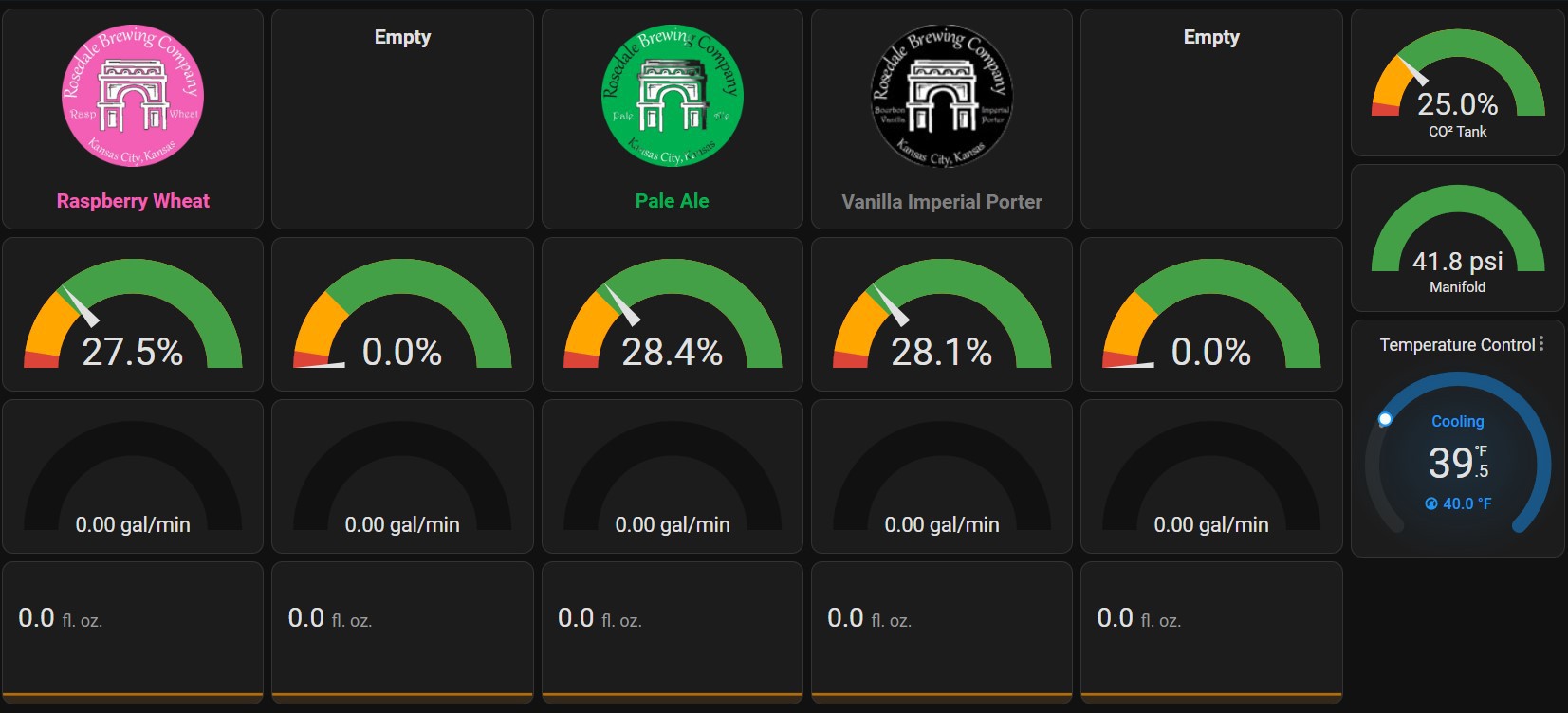
One thing that has changed significantly since I originally built the Keezer, is I go through less and less beer over time. I’ve never been a huge ‘beer drinker’ and have really only ever imbibed when we have friends over, but between the pandemic, kids and just life, it seems that we have occasions like this less and less. In the past, I always kept all 5 kegs full and immediately started brewing when a keg got low or ran out. Going forward, my plan is to only keep ~2 beers on tap at a given time plus likely a small keg of either homemade Ginger Beer (super-easy to make, quite tasty and great for mixed drinks) or store-bought root beer for our kids. I’m sure this will change over time, but having each beer on hand for so long made the entire hobby less fun and brewing had started to become a chore. I’m looking forward to having fun brewing new beers now that I have an updated Keezer to enjoy them from!
ESPHome YAML:
esphome:
name: keezer
friendly_name: Keezer
esp32:
board: esp32dev
framework:
type: esp-idf
# Enable logging
logger:
# Enable Home Assistant API
api:
encryption:
key: "xxxxxxxxxxxxxxxxxxxxxxxxxxxx"
ota:
password: "xxxxxxxxxxxxxxxxxxxxxxxxxxxxxxxxxxxx
wifi:
ssid: !secret wifi_ssid
password: !secret wifi_password
# Enable fallback hotspot (captive portal) in case wifi connection fails
ap:
ssid: "Keezer Fallback Hotspot"
password: "xxxxxxxxxxxxxxxxx"
#Removed for Bluetooth Proxy feature
#captive_portal:
bluetooth_proxy:
active: true
esp32_ble_tracker:
status_led:
pin:
number: GPIO2
button:
- platform: restart
name: Restart
- platform: safe_mode
name: Restart (Safe Mode)
# Keg 1 Pulse Counter Reset Button
- platform: template
name: Keg 1 Reset Pulse Counter Total
on_press:
- pulse_meter.set_total_pulses:
id: keg_1_pulse_meter
value: 0
# Keg 2 Pulse Counter Reset Button
- platform: template
name: Keg 2 Reset Pulse Counter Total
on_press:
- pulse_meter.set_total_pulses:
id: keg_2_pulse_meter
value: 0
# Keg 3 Pulse Counter Reset Button
- platform: template
name: Keg 3 Reset Pulse Counter Total
on_press:
- pulse_meter.set_total_pulses:
id: keg_3_pulse_meter
value: 0
# Keg 4 Pulse Counter Reset Button
- platform: template
name: Keg 4 Reset Pulse Counter Total
on_press:
- pulse_meter.set_total_pulses:
id: keg_4_pulse_meter
value: 0
# Keg 5 Pulse Counter Reset Button
- platform: template
name: Keg 5 Reset Pulse Counter Total
on_press:
- pulse_meter.set_total_pulses:
id: keg_5_pulse_meter
value: 0
number:
#REMOVED RESTORE VALUES TO KEEP FROM WEARING OUT THE FLASH WHILE TESTING
# Keg 1 Full Volume
- platform: template
name: Keg 1 Full
optimistic: true
id: keg_1_full_value
icon: mdi:gauge-full
device_class: volume_storage
unit_of_measurement: gal
max_value: 6
min_value: 0
step: 0.01
initial_value: 5
mode: box
# restore_value: true
# Keg 2 Full Volume
- platform: template
name: Keg 2 Full
optimistic: true
id: keg_2_full_value
icon: mdi:gauge-full
device_class: volume_storage
unit_of_measurement: gal
max_value: 6
min_value: 0
step: 0.01
initial_value: 5
mode: box
# restore_value: true
# Keg 3 Full Volume
- platform: template
name: Keg 3 Full
optimistic: true
id: keg_3_full_value
icon: mdi:gauge-full
device_class: volume_storage
unit_of_measurement: gal
max_value: 6
min_value: 0
step: 0.01
initial_value: 5
mode: box
# restore_value: true
# Keg 4 Full Volume
- platform: template
name: Keg 4 Full
optimistic: true
id: keg_4_full_value
icon: mdi:gauge-full
device_class: volume_storage
unit_of_measurement: gal
max_value: 6
min_value: 0
step: 0.01
initial_value: 5
mode: box
# restore_value: true
# Keg 5 Full Volume
- platform: template
name: Keg 5 Full
optimistic: true
id: keg_5_full_value
icon: mdi:gauge-full
device_class: volume_storage
unit_of_measurement: gal
max_value: 6
min_value: 0
step: 0.01
initial_value: 1.5
mode: box
# restore_value: true
# Keg 1 Consumed (Only updated on Keezer Shutdown)
- platform: template
name: Keg 1 Consumed LTS
optimistic: true
id: keg_1_consumed_value_lts
icon: mdi:gauge
device_class: volume_storage
unit_of_measurement: gal
max_value: 6
min_value: 0
step: 0.01
initial_value: 0
mode: box
# restore_value: true
# Keg 2 Consumed (Only updated on Keezer Shutdown)
- platform: template
name: Keg 2 Consumed LTS
optimistic: true
id: keg_2_consumed_value_lts
icon: mdi:gauge
device_class: volume_storage
unit_of_measurement: gal
max_value: 6
min_value: 0
step: 0.01
initial_value: 0
mode: box
# restore_value: true
# Keg 3 Consumed (Only updated on Keezer Shutdown)
- platform: template
name: Keg 3 Consumed LTS
optimistic: true
id: keg_3_consumed_value_lts
icon: mdi:gauge
device_class: volume_storage
unit_of_measurement: gal
max_value: 6
min_value: 0
step: 0.01
initial_value: 0
mode: box
# restore_value: true
# Keg 4 Consumed (Only updated on Keezer Shutdown)
- platform: template
name: Keg 4 Consumed LTS
optimistic: true
id: keg_4_consumed_value_lts
icon: mdi:gauge
device_class: volume_storage
unit_of_measurement: gal
max_value: 6
min_value: 0
step: 0.01
initial_value: 0
mode: box
# restore_value: true
# Keg 5 Consumed (Only updated on Keezer Shutdown)
- platform: template
name: Keg 5 Consumed LTS
optimistic: true
id: keg_5_consumed_value_lts
icon: mdi:gauge
device_class: volume_storage
unit_of_measurement: gal
max_value: 6
min_value: 0
step: 0.01
initial_value: 0
mode: box
# restore_value: true
# Keg 1 Pulse Conversion
- platform: template
name: Keg 1 Pulse Conversion
optimistic: true
id: keg_1_pulse_conversion
icon: mdi:pulse
unit_of_measurement: pulses/gal
max_value: 5000
min_value: 0
step: 1
initial_value: 2566
mode: box
# restore_value: true
# Keg 2 Pulse Conversion
- platform: template
name: Keg 2 Pulse Conversion
optimistic: true
id: keg_2_pulse_conversion
icon: mdi:pulse
unit_of_measurement: pulses/gal
max_value: 5000
min_value: 0
step: 1
initial_value: 2566
mode: box
# restore_value: true
# Keg 3 Pulse Conversion
- platform: template
name: Keg 3 Pulse Conversion
optimistic: true
id: keg_3_pulse_conversion
icon: mdi:pulse
unit_of_measurement: pulses/gal
max_value: 5000
min_value: 0
step: 1
initial_value: 2566
mode: box
# restore_value: true
# Keg 4 Pulse Conversion
- platform: template
name: Keg 4 Pulse Conversion
optimistic: true
id: keg_4_pulse_conversion
icon: mdi:pulse
unit_of_measurement: pulses/gal
max_value: 5000
min_value: 0
step: 1
initial_value: 2566
mode: box
# restore_value: true
# Keg 5 Pulse Conversion
- platform: template
name: Keg 5 Pulse Conversion
optimistic: true
id: keg_5_pulse_conversion
icon: mdi:pulse
unit_of_measurement: pulses/gal
max_value: 5000
min_value: 0
step: 1
initial_value: 2566
mode: box
# restore_value: true
switch:
# Keezer Switch
- platform: template
name: Keezer
id: keezer_switch
icon: mdi:glass-mug-variant
optimistic: true
turn_on_action:
# - if:
# condition:
# - light.is_off: keezer_lights
# then:
#Tap 1 LEDs
# - light.turn_on:
# id: tap_1_leds
# brightness: 100%
# red: 95%
# green: 37%
# blue: 71%
#Tap 3 LEDs
# - light.turn_on:
# id: tap_3_leds
# brightness: 100%
# red: 0%
# green: 69%
# blue: 31%
#Tap 4 LEDs
# - light.turn_on:
# id: tap_4_leds
# brightness: 100%
# red: 50%
# green: 50%
# blue: 50%
# else:
#Tap 1 LEDs
# - light.turn_on:
# id: tap_1_leds
# brightness: 100%
# red: 95%
# green: 37%
# blue: 71%
#Tap 3 LEDs
# - light.turn_on:
# id: tap_3_leds
# brightness: 100%
# red: 0%
# green: 69%
# blue: 31%
#Tap 4 LEDs
# - light.turn_on:
# id: tap_4_leds
# brightness: 100%
# red: 50%
# green: 50%
# blue: 50%
- light.turn_on:
id: keezer_lights
brightness: 100%
red: 0%
green: 5%
blue: 100%
- switch.turn_on: keg_valves
- pulse_meter.set_total_pulses:
id: keg_1_pulse_meter
value: 0
- pulse_meter.set_total_pulses:
id: keg_2_pulse_meter
value: 0
- pulse_meter.set_total_pulses:
id: keg_3_pulse_meter
value: 0
- pulse_meter.set_total_pulses:
id: keg_4_pulse_meter
value: 0
- pulse_meter.set_total_pulses:
id: keg_5_pulse_meter
value: 0
turn_off_action:
# - light.turn_off:
# id: tap_1_leds
# - light.turn_off:
# id: tap_2_leds
# - light.turn_off:
# id: tap_3_leds
# - light.turn_off:
# id: tap_4_leds
# - light.turn_off:
# id: tap_5_leds
- light.turn_off:
id: keezer_lights
- switch.turn_off: keg_valves
- number.set:
id: keg_1_consumed_value_lts
value: !lambda "return (id(keg_1_consumed_value_lts).state + (id(keg_1_poured_volume).state * 0.0078125));"
- number.set:
id: keg_2_consumed_value_lts
value: !lambda "return (id(keg_2_consumed_value_lts).state + (id(keg_2_poured_volume).state * 0.0078125));"
- number.set:
id: keg_3_consumed_value_lts
value: !lambda "return (id(keg_3_consumed_value_lts).state + (id(keg_3_poured_volume).state * 0.0078125));"
- number.set:
id: keg_4_consumed_value_lts
value: !lambda "return (id(keg_4_consumed_value_lts).state + (id(keg_4_poured_volume).state * 0.0078125));"
- number.set:
id: keg_5_consumed_value_lts
value: !lambda "return (id(keg_5_consumed_value_lts).state + (id(keg_5_poured_volume).state * 0.0078125));"
- pulse_meter.set_total_pulses:
id: keg_1_pulse_meter
value: 0
- pulse_meter.set_total_pulses:
id: keg_2_pulse_meter
value: 0
- pulse_meter.set_total_pulses:
id: keg_3_pulse_meter
value: 0
- pulse_meter.set_total_pulses:
id: keg_4_pulse_meter
value: 0
- pulse_meter.set_total_pulses:
id: keg_5_pulse_meter
value: 0
# Keg Valves
- platform: gpio
pin: GPIO19
name: Keg Valves
id: keg_valves
device_class: switch
icon: mdi:pipe-valve
# Freezer Relay
- platform: gpio
pin: GPIO26
name: Freezer Relay
id: freezer_relay
device_class: switch
icon: mdi:snowflake-thermometer
text_sensor:
- platform: wifi_info
ip_address:
name: IP Address
sensor:
# Send WiFi signal strength & uptime to HA
- platform: wifi_signal
name: WiFi Strength
update_interval: 60s
disabled_by_default: true
- platform: uptime
name: Uptime
disabled_by_default: true
# Keg 1 Pulse Meter
- platform: pulse_meter
pin: GPIO4
name: Keg 1 Pulse Meter
id: keg_1_pulse_meter
internal_filter: 20us #Default is 13us. Used 20, 10, 5, 2 with Pulse and no noise.
internal_filter_mode: PULSE
timeout: 1s
total:
name: Keg 1 Total Pulses
id: keg_1_pulse_meter_total
# Keg 2 Pulse Meter
- platform: pulse_meter
pin: GPIO13
name: Keg 2 Pulse Meter
id: keg_2_pulse_meter
internal_filter: 20us #Default is 13us. Used 20, 10, 5, 2 with Pulse and no noise.
internal_filter_mode: PULSE
timeout: 1s
total:
name: Keg 2 Total Pulses
id: keg_2_pulse_meter_total
# Keg 3 Pulse Meter
- platform: pulse_meter
pin: GPIO16
name: Keg 3 Pulse Meter
id: keg_3_pulse_meter
internal_filter: 20us #Default is 13us. Used 20, 10, 5, 2 with Pulse and no noise.
internal_filter_mode: PULSE
timeout: 1s
total:
name: Keg 3 Total Pulses
id: keg_3_pulse_meter_total
# Keg 4 Pulse Meter
- platform: pulse_meter
pin: GPIO17
name: Keg 4 Pulse Meter
id: keg_4_pulse_meter
internal_filter: 20us #Default is 13us. Used 20, 10, 5, 2 with Pulse and no noise.
internal_filter_mode: PULSE
timeout: 1s
total:
name: Keg 4 Total Pulses
id: keg_4_pulse_meter_total
# Keg 5 Pulse Meter
- platform: pulse_meter
pin: GPIO18
name: Keg 5 Pulse Meter
id: keg_5_pulse_meter
internal_filter: 20us #Default is 13us. Used 20, 10, 5, 2 with Pulse and no noise.
internal_filter_mode: PULSE
timeout: 1s
total:
name: Keg 5 Total Pulses
id: keg_5_pulse_meter_total
# Keg 1 Percent Full
- platform: template
name: Keg 1 Percent Full
id: keg_1_percent_full
state_class: measurement
unit_of_measurement: "%"
icon: mdi:keg
lambda: |-
if (id(keezer_switch).state and (id(keg_1_pulse_meter_total).state > 10)) {
return (((id(keg_1_full_value).state - (id(keg_1_consumed_value_lts).state + (id(keg_1_pulse_meter_total).state * (1 / id(keg_1_pulse_conversion).state)))) / (id(keg_1_full_value).state)) * 100);
} else {
return (((id(keg_1_full_value).state - id(keg_1_consumed_value_lts).state) / (id(keg_1_full_value).state)) * 100);
}
update_interval: 1s
# Keg 2 Percent Full
- platform: template
name: Keg 2 Percent Full
id: keg_2_percent_full
state_class: measurement
unit_of_measurement: "%"
icon: mdi:keg
lambda: |-
if (id(keezer_switch).state and (id(keg_2_pulse_meter_total).state > 10)) {
return (((id(keg_2_full_value).state - (id(keg_2_consumed_value_lts).state + (id(keg_2_pulse_meter_total).state * (1 / id(keg_2_pulse_conversion).state)))) / (id(keg_2_full_value).state)) * 100);
} else {
return (((id(keg_2_full_value).state - id(keg_2_consumed_value_lts).state) / (id(keg_2_full_value).state)) * 100);
}
update_interval: 1s
# Keg 3 Percent Full
- platform: template
name: Keg 3 Percent Full
id: keg_3_percent_full
state_class: measurement
unit_of_measurement: "%"
icon: mdi:keg
lambda: |-
if (id(keezer_switch).state and (id(keg_3_pulse_meter_total).state > 10)) {
return (((id(keg_3_full_value).state - (id(keg_3_consumed_value_lts).state + (id(keg_3_pulse_meter_total).state * (1 / id(keg_3_pulse_conversion).state)))) / (id(keg_3_full_value).state)) * 100);
} else {
return (((id(keg_3_full_value).state - id(keg_3_consumed_value_lts).state) / (id(keg_3_full_value).state)) * 100);
}
update_interval: 1s
# Keg 4 Percent Full
- platform: template
name: Keg 4 Percent Full
id: keg_4_percent_full
state_class: measurement
unit_of_measurement: "%"
icon: mdi:keg
lambda: |-
if (id(keezer_switch).state and (id(keg_4_pulse_meter_total).state > 10)) {
return (((id(keg_4_full_value).state - (id(keg_4_consumed_value_lts).state + (id(keg_4_pulse_meter_total).state * (1 / id(keg_4_pulse_conversion).state)))) / (id(keg_4_full_value).state)) * 100);
} else {
return (((id(keg_4_full_value).state - id(keg_4_consumed_value_lts).state) / (id(keg_4_full_value).state)) * 100);
}
update_interval: 1s
# Keg 5 Percent Full
- platform: template
name: Keg 5 Percent Full
id: keg_5_percent_full
state_class: measurement
unit_of_measurement: "%"
icon: mdi:keg
lambda: |-
if (id(keezer_switch).state and (id(keg_5_pulse_meter_total).state > 10)) {
return (((id(keg_5_full_value).state - (id(keg_5_consumed_value_lts).state + (id(keg_5_pulse_meter_total).state * (1 / id(keg_5_pulse_conversion).state)))) / (id(keg_5_full_value).state)) * 100);
} else {
return (((id(keg_5_full_value).state - id(keg_5_consumed_value_lts).state) / (id(keg_5_full_value).state)) * 100);
}
update_interval: 1s
# Keg 1 Poured Volume
- platform: template
name: Keg 1 Poured Volume
id: keg_1_poured_volume
device_class: volume_storage
state_class: measurement
unit_of_measurement: fl. oz.
accuracy_decimals: 1
icon: mdi:beer
lambda: |-
if (id(keezer_switch).state and (id(keg_1_pulse_meter_total).state > 10)) {
return ((id(keg_1_pulse_meter_total).state * (1 / id(keg_1_pulse_conversion).state)) * 128);
} else {
return 0;
}
update_interval: 1s
# Keg 2 Poured Volume
- platform: template
name: Keg 2 Poured Volume
id: keg_2_poured_volume
device_class: volume_storage
state_class: measurement
unit_of_measurement: fl. oz.
accuracy_decimals: 1
icon: mdi:beer
lambda: |-
if (id(keezer_switch).state and (id(keg_2_pulse_meter_total).state > 10)) {
return ((id(keg_2_pulse_meter_total).state * (1 / id(keg_2_pulse_conversion).state)) * 128);
} else {
return 0;
}
update_interval: 1s
# Keg 3 Poured Volume
- platform: template
name: Keg 3 Poured Volume
id: keg_3_poured_volume
device_class: volume_storage
state_class: measurement
unit_of_measurement: fl. oz.
accuracy_decimals: 1
icon: mdi:beer
lambda: |-
if (id(keezer_switch).state and (id(keg_3_pulse_meter_total).state > 10)) {
return ((id(keg_3_pulse_meter_total).state * (1 / id(keg_3_pulse_conversion).state)) * 128);
} else {
return 0;
}
update_interval: 1s
# Keg 4 Poured Volume
- platform: template
name: Keg 4 Poured Volume
id: keg_4_poured_volume
device_class: volume_storage
state_class: measurement
unit_of_measurement: fl. oz.
accuracy_decimals: 1
icon: mdi:beer
lambda: |-
if (id(keezer_switch).state and (id(keg_4_pulse_meter_total).state > 10)) {
return ((id(keg_4_pulse_meter_total).state * (1 / id(keg_4_pulse_conversion).state)) * 128);
} else {
return 0;
}
update_interval: 1s
# Keg 5 Poured Volume
- platform: template
name: Keg 5 Poured Volume
id: keg_5_poured_volume
device_class: volume_storage
state_class: measurement
unit_of_measurement: fl. oz.
accuracy_decimals: 1
icon: mdi:beer
lambda: |-
if (id(keezer_switch).state and (id(keg_5_pulse_meter_total).state > 10)) {
return ((id(keg_5_pulse_meter_total).state * (1 / id(keg_5_pulse_conversion).state)) * 128);
} else {
return 0;
}
update_interval: 1s
# Keg 1 Flowrate
- platform: template
name: Keg 1 Flowrate
id: keg_1_flowrate
device_class: volume_flow_rate
state_class: measurement
unit_of_measurement: gal/min
accuracy_decimals: 2
icon: mdi:water-pump
lambda: |-
if (id(keezer_switch).state) {
return ((id(keg_1_pulse_meter).state * (1 / id(keg_1_pulse_conversion).state)));
} else {
return 0;
}
update_interval: 1s
# Keg 2 Flowrate
- platform: template
name: Keg 2 Flowrate
id: keg_2_flowrate
device_class: volume_flow_rate
state_class: measurement
unit_of_measurement: gal/min
accuracy_decimals: 2
icon: mdi:water-pump
lambda: |-
if (id(keezer_switch).state) {
return ((id(keg_2_pulse_meter).state * (1 / id(keg_2_pulse_conversion).state)));
} else {
return 0;
}
update_interval: 1s
# Keg 3 Flowrate
- platform: template
name: Keg 3 Flowrate
id: keg_3_flowrate
device_class: volume_flow_rate
state_class: measurement
unit_of_measurement: gal/min
accuracy_decimals: 2
icon: mdi:water-pump
lambda: |-
if (id(keezer_switch).state) {
return ((id(keg_3_pulse_meter).state * (1 / id(keg_3_pulse_conversion).state)));
} else {
return 0;
}
update_interval: 1s
# Keg 4 Flowrate
- platform: template
name: Keg 4 Flowrate
id: keg_4_flowrate
device_class: volume_flow_rate
state_class: measurement
unit_of_measurement: gal/min
accuracy_decimals: 2
icon: mdi:water-pump
lambda: |-
if (id(keezer_switch).state) {
return ((id(keg_4_pulse_meter).state * (1 / id(keg_4_pulse_conversion).state)));
} else {
return 0;
}
update_interval: 1s
# Keg 5 Flowrate
- platform: template
name: Keg 5 Flowrate
id: keg_5_flowrate
device_class: volume_flow_rate
state_class: measurement
unit_of_measurement: gal/min
accuracy_decimals: 2
icon: mdi:water-pump
lambda: |-
if (id(keezer_switch).state) {
return ((id(keg_5_pulse_meter).state * (1 / id(keg_5_pulse_conversion).state)));
} else {
return 0;
}
update_interval: 1s
# Gas Weight RAW Sensor
- platform: hx711
# name: Gas Value RAW
# id: gas_value_raw
name: Gas Percent Full
id: gas_percent_full
state_class: measurement
unit_of_measurement: "%"
accuracy_decimals: 1
dout_pin: GPIO21
clk_pin: GPIO22
update_interval: 1s #Used 0.1s for Beehive
filters:
# Used this avergae for the Beehive
- sliding_window_moving_average:
window_size: 600
send_every: 15
send_first_at: 15
# From Particle Code
# Gas_Empty_Calibration=7213399;
# Gas_Full_Calibration=7335977;
# Actual readings are showing as negative
- calibrate_linear:
method: least_squares
datapoints:
- -7213399 -> 0
- -7335977 -> 100
# Temperature Sensor
- platform: dallas
address: 0xff3190d4454bfa28
name: Keezer Temperature
id: keezer_temperature
# Pressure Transducer
- platform: adc
pin: GPIO39
name: Gas Pressure
icon: mdi:gas-cylinder
unit_of_measurement: psi
device_class: pressure
state_class: measurement
accuracy_decimals: 1
update_interval: 1s
attenuation: auto
filters:
# - median:
# window_size: 11
# send_every: 11
# send_first_at: 11
- sliding_window_moving_average:
window_size: 15
send_every: 15
send_first_at: 15
- calibrate_linear:
method: least_squares
datapoints:
# Sensor advertises 0.5V=0psi & 4.5V=100psi. These values are from testing (using the analog gauge on the gas tank):
- 0.28 -> 0
- 1.98 -> 40
- clamp:
min_value: 0
max_value: 100
ignore_out_of_range: false #This determines whether it just ignores out of range values or treats them as a max/min value
binary_sensor:
# Lid Sensor
- platform: gpio
pin:
number: GPIO23
inverted: true
mode:
input: true
pullup: true
name: Keezer Lid
id: keezer_lid
device_class: door
on_press:
then:
- light.turn_on: interior_lights
on_release:
then:
- light.turn_off: interior_lights
light:
# Interior Lights
- platform: binary
name: Interior Lights
id: interior_lights
icon: mdi:led-strip
output: interior_lights_output
# Keezer Lights
# - platform: neopixelbus
# type: GRB
# variant: WS2812
# pin: GPIO27
# num_leds: 37
# name: Keezer Lights
# id: keezer_lights
# icon: mdi:wall-sconce-flat
- platform: partition
name: "Tap #1 LEDs"
id: tap_1_leds
segments:
- id: keezer_lights
from: 0
to: 7
- platform: partition
name: "Tap #2 LEDs"
id: tap_2_leds
segments:
- id: keezer_lights
from: 8
to: 14
- platform: partition
name: "Tap #3 LEDs"
id: tap_3_leds
segments:
- id: keezer_lights
from: 15
to: 21
- platform: partition
name: "Tap #4 LEDs"
id: tap_4_leds
segments:
- id: keezer_lights
from: 22
to: 28
- platform: partition
name: "Tap #5 LEDs"
id: tap_5_leds
segments:
- id: keezer_lights
from: 29
to: 36
- platform: esp32_rmt_led_strip
name: Keezer Lights
id: keezer_lights
icon: mdi:wall-sconce-flat
rgb_order: GRB
is_rgbw: False
pin: GPIO27
num_leds: 37
rmt_channel: 0
chipset: WS2812
max_refresh_rate: 200ms #16ms ~= 60Hz # 100ms seemed to help quite a bit, but still got some flicker at times
effects:
- addressable_color_wipe:
name: Christmas Wipe
colors:
- red: 100%
green: 0%
blue: 0%
white: 0%
num_leds: 15
- red: 0%
green: 100%
blue: 0%
white: 0%
num_leds: 15
add_led_interval: 200ms
reverse: false
- addressable_color_wipe:
name: Chiefs Wipe
colors:
- red: 100%
green: 0%
blue: 0%
white: 0%
num_leds: 15
- red: 100%
green: 87%
blue: 0%
white: 0%
num_leds: 15
add_led_interval: 200ms
reverse: false
- random:
name: Random
transition_length: 5s
update_interval: 7s
- addressable_rainbow:
name: Rainbow
speed: 10
width: 50
- addressable_color_wipe:
name: Random Color Wipe
colors:
- random: true
num_leds: 15
add_led_interval: 200ms
reverse: false
output:
# Interior Lights
- id: interior_lights_output
platform: gpio
pin: GPIO25
# Freezer Temperature Controller
climate:
- platform: thermostat
name: Thermostat
sensor: keezer_temperature
visual:
min_temperature: 32 °F
max_temperature: 60 °F
temperature_step: 0.5 °F
min_cooling_off_time: 300s
min_cooling_run_time: 120s
min_idle_time: 300s
cool_action:
- switch.turn_on: freezer_relay
idle_action:
- switch.turn_off: freezer_relay
default_preset: Beer
on_boot_restore_from: memory
preset:
- name: Beer
mode: COOL
default_target_temperature_high: 40 °F
dallas:
- pin: GPIO32
update_interval: 15s
 Ben Brooks
Ben Brooks